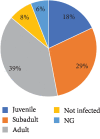Zoonotic Gastrointestinal Parasites of Baboons (Papio anubis) in the Shai Hill Reserve in Ghana
- PMID: 32258100
- PMCID: PMC7086414
- DOI: 10.1155/2020/1083251
Zoonotic Gastrointestinal Parasites of Baboons (Papio anubis) in the Shai Hill Reserve in Ghana
Abstract
Several intestinal parasites of baboons are of zoonotic importance, especially where there is considerable interaction between the baboons and humans. The identification of gastrointestinal parasite infections of baboons (Papio anubis) was undertaken at the Shai Hills Reserve Resort, Ghana. A total of 51 faecal samples were collected randomly from individual baboons (51) and examined for cysts, eggs, and larvae of parasites of medical importance, using the direct saline smear and formol-ether concentration technique. The baboons were in 7 troops and were grouped into juveniles, subadults, and adults. The survey showed that 92% of the baboon samples examined were infected with at least one or more parasite(s) of medical importance. Hookworm had the highest prevalence of 38.39% followed by Ascaris lumbricoides (22.32%), whilst Diphyllobotrium latum recorded the lowest prevalence of 0.89%. Adults had the highest prevalence of A. lumbricoides (35.42%). Hookworm (47.92%) occurred most in the juveniles. This is the first report of intestinal parasitic infection in baboons within the Shai Hills Reserve. The results showed a high level of multiparasitism in the nonhuman primates, thus the need for possible interventions to maintain ecosystem health and control the infections as they may be a potential source of transmission to humans.
Copyright © 2020 John Asiedu Larbi et al.
Conflict of interest statement
Authors declare that there are no conflicts of interest with regards to the findings of this study.
Figures
Similar articles
-
Distribution of intestinal parasites of baboons (Papio anubis) and warthogs (Phacochoerus aethiopicus) at the Mole National Park, Ghana.Vet Med Sci. 2021 Jan;7(1):251-255. doi: 10.1002/vms3.335. Epub 2020 Aug 9. Vet Med Sci. 2021. PMID: 32772510 Free PMC article.
-
A survey of gastrointestinal parasites of olive baboons (Papio anubis) in human settlement areas of Mole National Park, Ghana.J Parasitol. 2012 Aug;98(4):885-8. doi: 10.1645/GE-2976.1. Epub 2012 Feb 2. J Parasitol. 2012. PMID: 22300265
-
Baboons as potential reservoirs of zoonotic gastrointestinal parasite infections at Yankari National Park, Nigeria.Afr Health Sci. 2013 Jun;13(2):252-4. doi: 10.4314/ahs.v13i2.7. Afr Health Sci. 2013. PMID: 24235920 Free PMC article.
-
Prevalence of intestinal parasitic infections among communities living in different habitats and its comparison with one hundred and one studies conducted over the past 42 years (1970 to 2013) in Malaysia.Trop Biomed. 2014 Jun;31(2):190-206. Trop Biomed. 2014. PMID: 25134888 Review.
-
Confessions of a baboon watcher: from inside to outside the paradigm.Primates. 2023 Jul;64(4):393-406. doi: 10.1007/s10329-023-01060-1. Epub 2023 May 10. Primates. 2023. PMID: 37165179 Free PMC article. Review.
Cited by
-
Gastrointestinal parasites of baboons (Papio papio) in Niokolo-Koba National Park, Senegal.Open Vet J. 2022 Jul-Aug;12(4):481-488. doi: 10.5455/OVJ.2022.v12.i4.9. Epub 2022 Jul 15. Open Vet J. 2022. PMID: 36118726 Free PMC article.
-
Eukaryotic composition across seasons and social groups in the gut microbiota of wild baboons.Anim Microbiome. 2025 Jun 21;7(1):70. doi: 10.1186/s42523-025-00436-6. Anim Microbiome. 2025. PMID: 40544290 Free PMC article.
-
Gastrointestinal parasite prevalence, diversity and association in free-ranging Chacma baboon troops in a semi-arid savanna ecosystem of Zimbabwe.Int J Parasitol Parasites Wildl. 2024 Oct 28;25:101012. doi: 10.1016/j.ijppaw.2024.101012. eCollection 2024 Dec. Int J Parasitol Parasites Wildl. 2024. PMID: 39553413 Free PMC article.
-
Gastrointestinal parasites in captive olive baboons in a UK safari park.Parasitology. 2023 Oct;150(12):1096-1104. doi: 10.1017/S0031182023000823. Epub 2023 Sep 1. Parasitology. 2023. PMID: 37655745 Free PMC article.
-
Eukaryotic composition across seasons and social groups in the gut microbiota of wild baboons.bioRxiv [Preprint]. 2024 Dec 17:2024.12.17.628920. doi: 10.1101/2024.12.17.628920. bioRxiv. 2024. Update in: Anim Microbiome. 2025 Jun 21;7(1):70. doi: 10.1186/s42523-025-00436-6. PMID: 39763902 Free PMC article. Updated. Preprint.
References
-
- Hawken C. M. Parasites, Natural Therapies for Prevention and Treatment. Pleasant Grove, Utah: Woodland Publishing; 1997.
-
- Kroeger H. Parasites: The Enemy Within. Boulder, CO, USA: Hanna Kroeger Publications; 1999.
-
- Gillespie T. R. Noninvasive assessment of gastrointestinal parasite Infections in free-ranging primates. International Journal of Primatology. 2006;27(4):1129–1143. doi: 10.1007/s10764-006-9064-x. - DOI
-
- Rowe N. The Pictorial Guide to the Living Primates. New York, NY, USA: Pogonias Press; 1996.
MeSH terms
LinkOut - more resources
Full Text Sources
Medical




